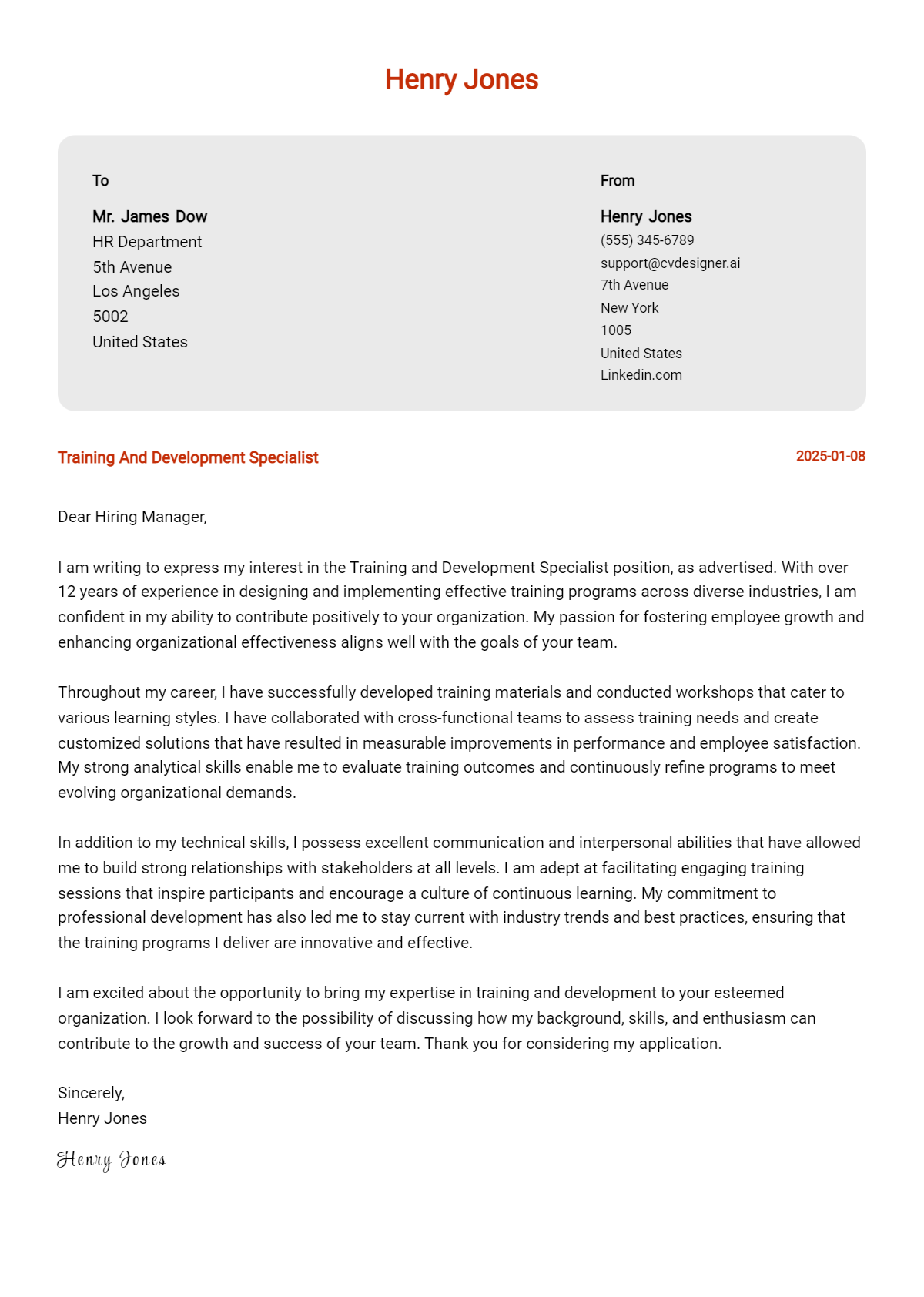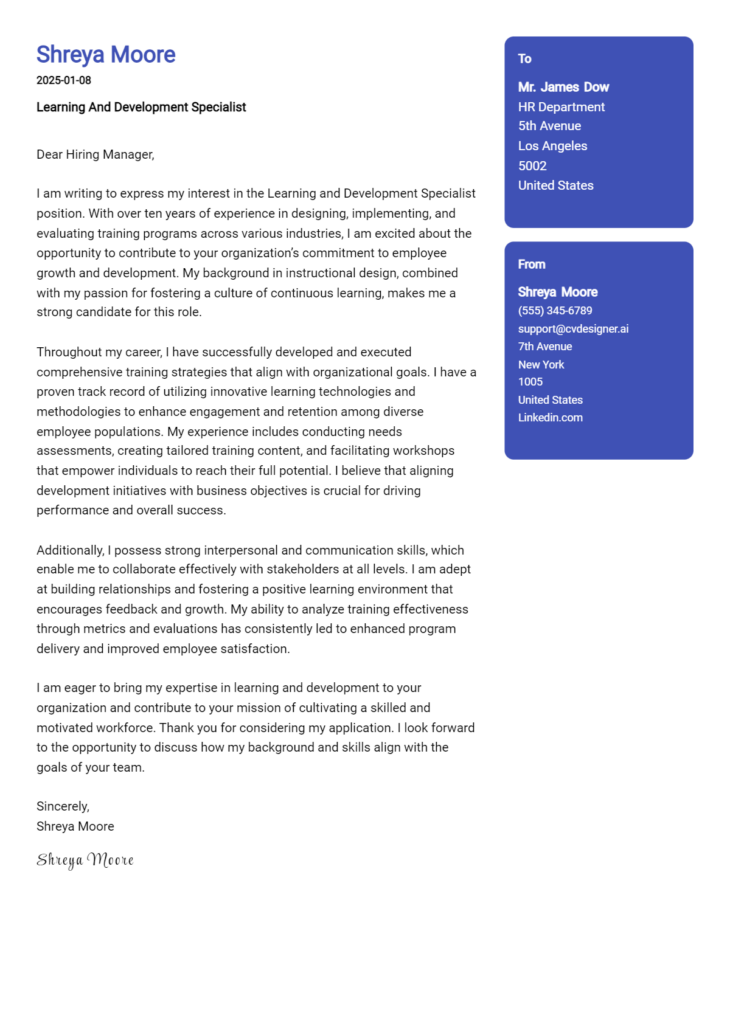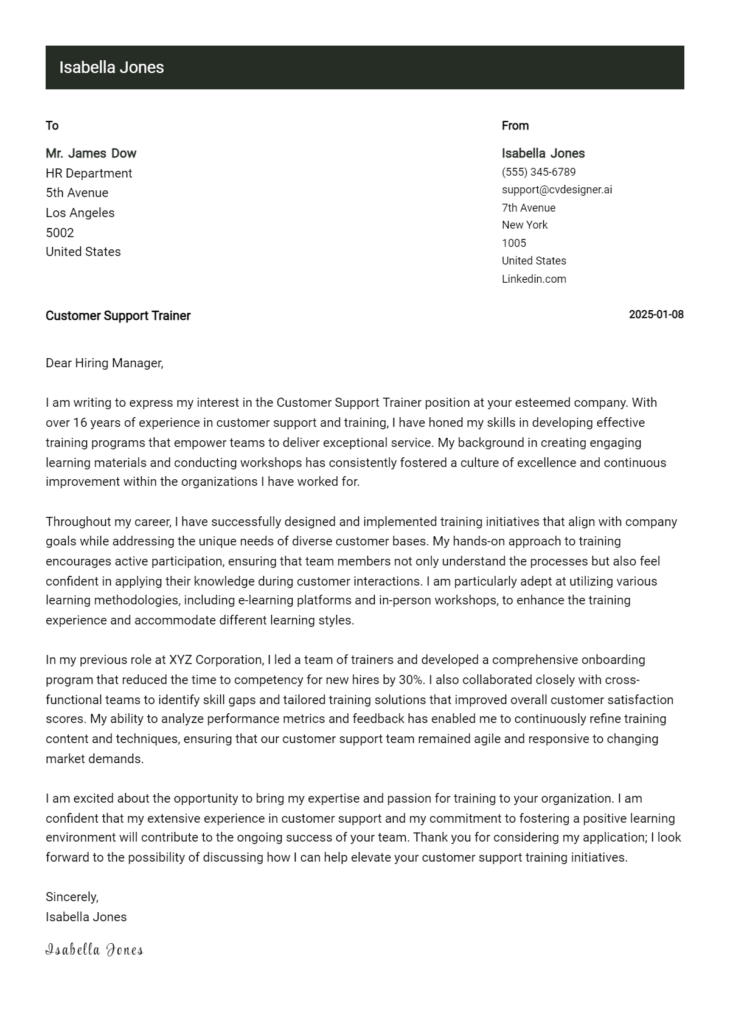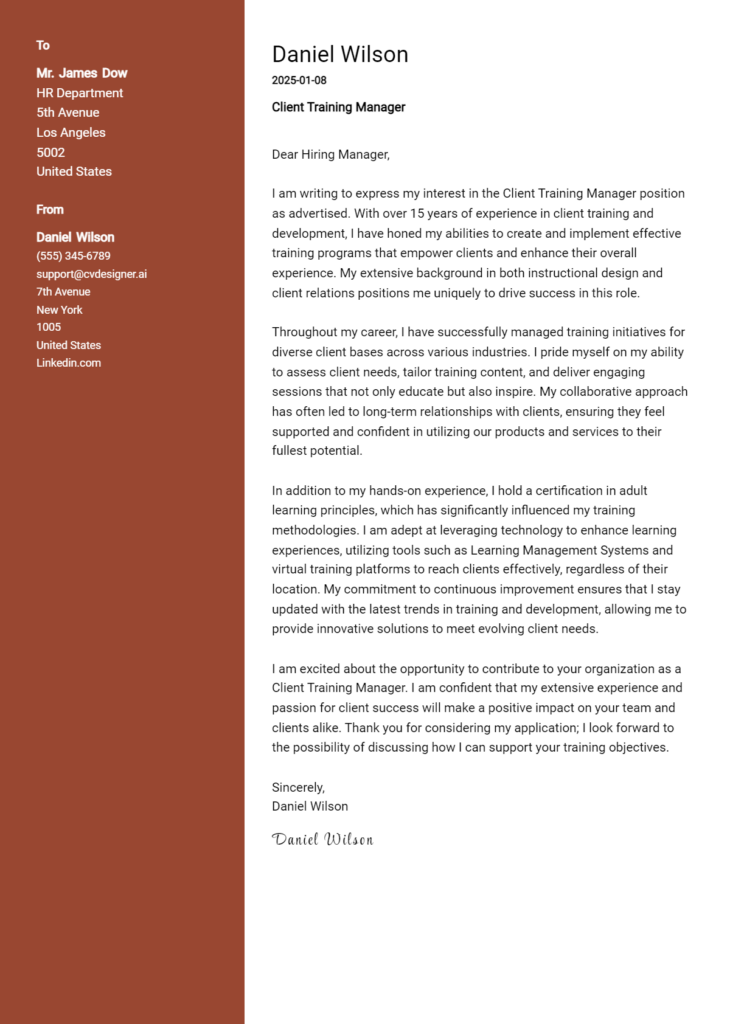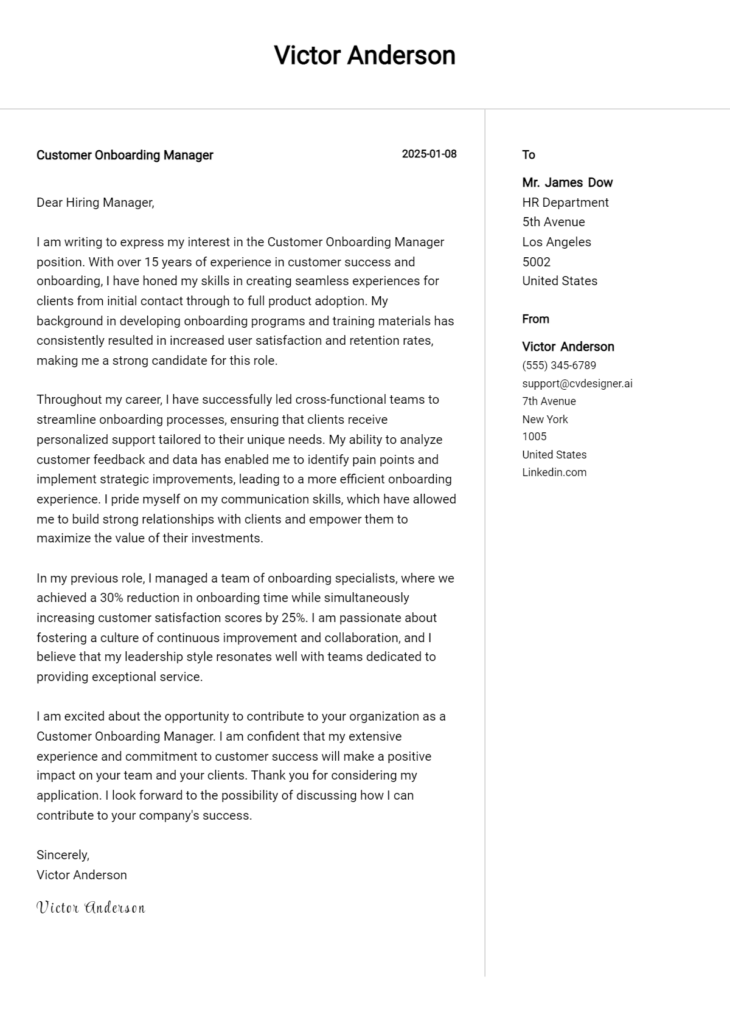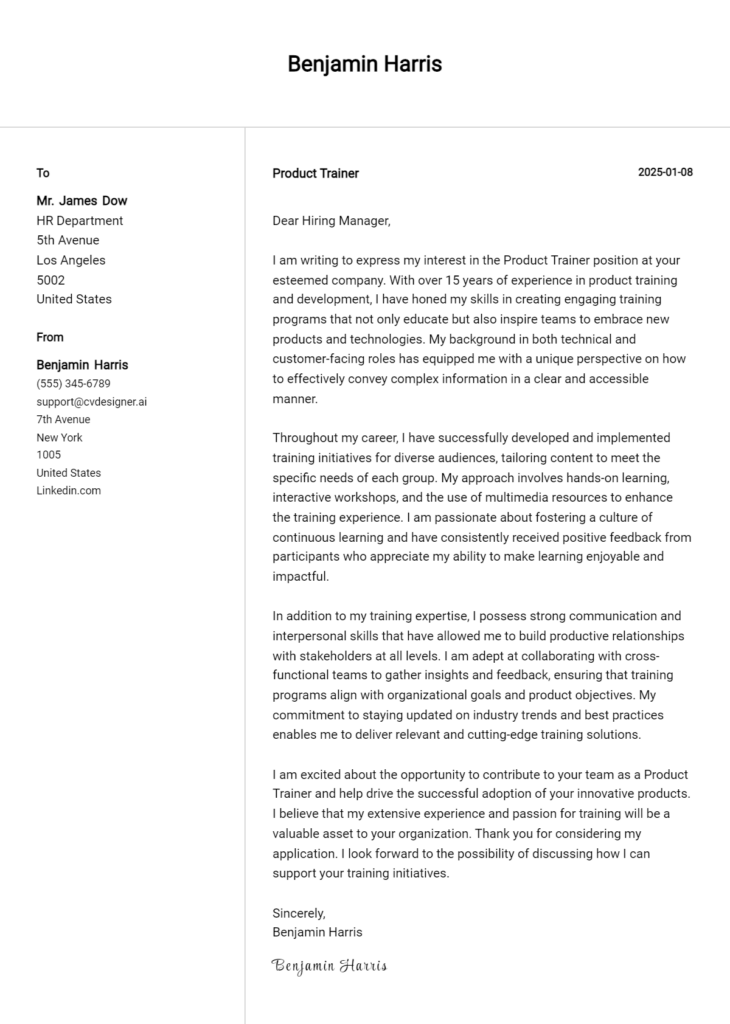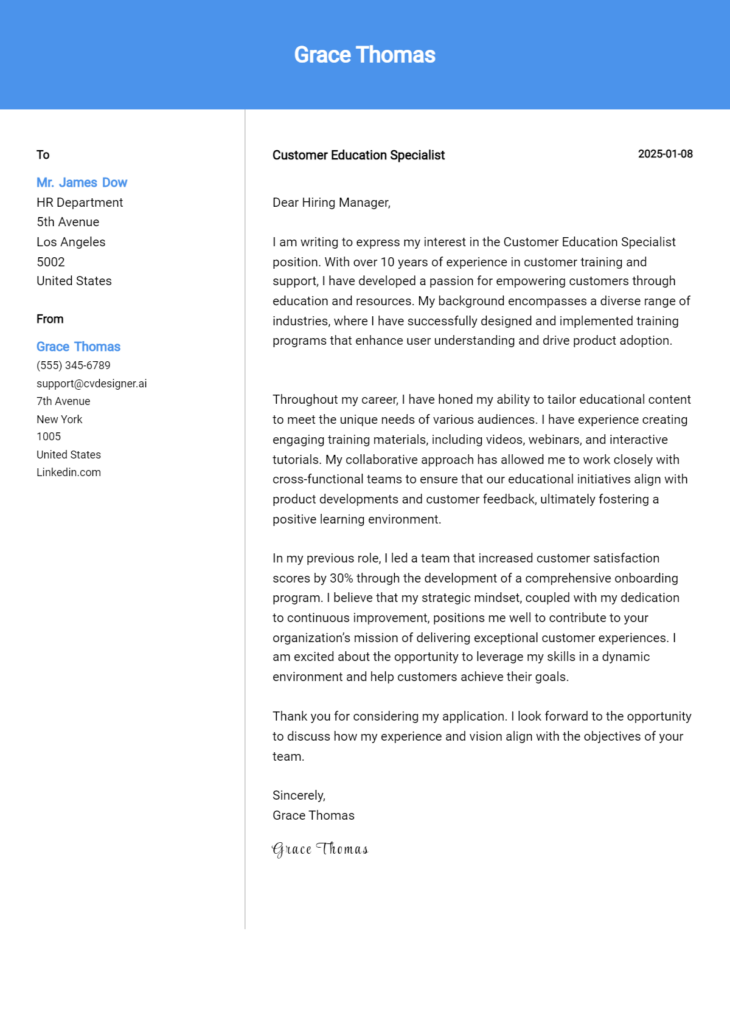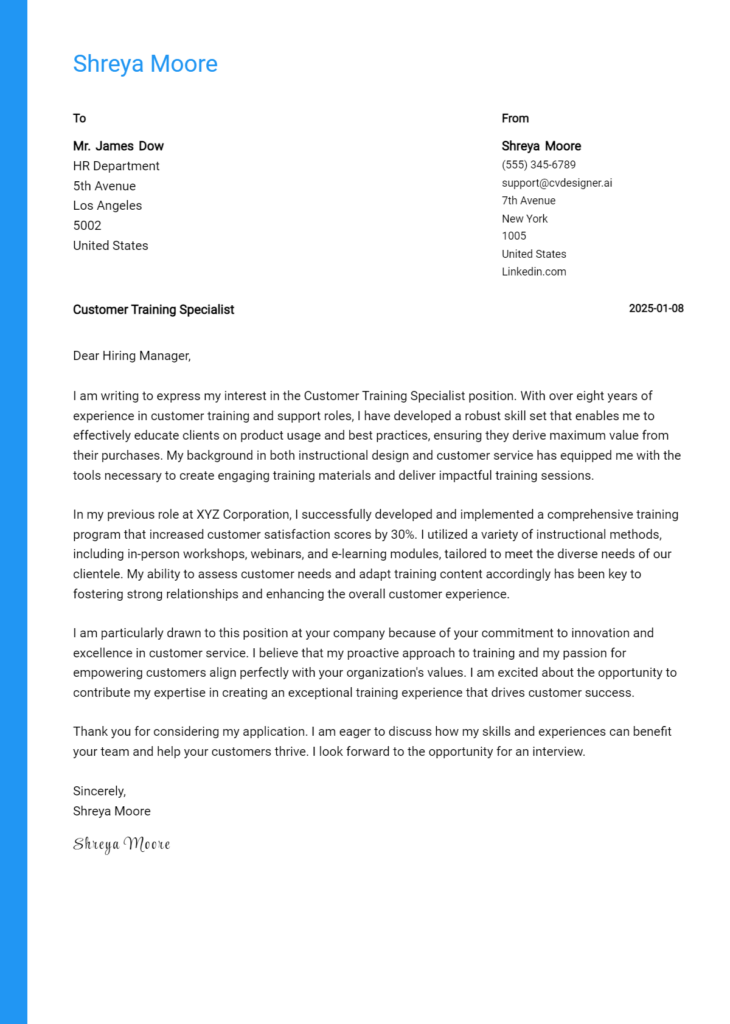Training And Development Specialist Cover Letter Examples
Explore additional Training And Development Specialist cover letter samples and guides and see what works for your level of experience or role.
How to Format a Training and Development Specialist Cover Letter?
Crafting a compelling cover letter is essential for a Training and Development Specialist, as it not only showcases your qualifications but also reflects your ability to communicate effectively and engage with diverse audiences. The formatting of your cover letter is crucial; it serves as a first impression of your organizational skills and professional demeanor—qualities that are vital in the training and development field.
In this guide, we will delve into the structure of your cover letter, providing insights and examples tailored specifically for Training and Development Specialists to help you create a standout document.
We will focus on the essential components of a professional cover letter, including:
- Cover Letter Header
- Cover Letter Greeting
- Cover Letter Introduction
- Cover Letter Body
- Cover Letter Closing
Each section is integral to showcasing your expertise and professionalism. Let’s break down each part and explain how to make your cover letter shine in the competitive landscape of training and development.
Importance of the Cover Letter Header for a Training and Development Specialist
The header of a cover letter is a critical component that sets the tone for the entire document. It establishes professionalism and clarity, providing essential information that allows the recipient to identify the sender and context of the communication quickly. A well-structured header should include the applicant's contact information, the date, and the recipient's details, ensuring that all parties are clearly identified. This clarity not only reflects the applicant's attention to detail but also enhances their credibility as a candidate for the Training and Development Specialist role.
A strong header demonstrates professionalism and organization, while a weak header can lead to confusion or an unprofessional impression. Below are examples of both a strong and a weak cover letter header for a Training and Development Specialist.
Strong Example
Jane Doe 1234 Training Lane Skill City, ST 12345 (123) 456-7890 jane.doe@email.com October 1, 2023 Mr. John Smith HR Director Company Name 5678 Development Drive Growth Town, ST 67890
Weak Example
Jane 10/1/23 To Whom It May Concern
The Importance of the Cover Letter Greeting
The greeting of a cover letter is crucial as it sets the tone for the entire document. A well-crafted greeting not only demonstrates professionalism but also personalizes your application by addressing the hiring manager directly. This initial connection can make a significant difference, as it shows that you have taken the time to research and understand the organization. Avoiding generic greetings, such as "To Whom It May Concern," is essential, as they can come off as impersonal and disengaged. Instead, investing a little time to find the recipient's name can enhance your letter's impact. If you cannot find a name, use a specific title or department instead.
Here are examples of strong and weak greetings for a Training and Development Specialist cover letter:
Strong Greeting Example
Dear Ms. Johnson,
Weak Greeting Example
To Whom It May Concern,
The Importance of a Compelling Cover Letter Introduction for a Training and Development Specialist
A well-crafted cover letter introduction is crucial for a Training and Development Specialist, as it sets the tone for the entire application and can significantly influence a hiring manager's perception. The introduction should not only capture the reader's attention but also convey genuine enthusiasm for the role. It’s an opportunity to succinctly highlight relevant skills or significant achievements that align with the job description. A strong introduction can create a lasting first impression, while a weak one may lead to a missed opportunity. Below are examples of both a strong and a weak cover letter introduction for this role.
Strong Example
Dear [Hiring Manager's Name], I am excited to apply for the Training and Development Specialist position at [Company Name], where I can leverage over five years of experience in designing impactful training programs that increase employee performance and engagement. My passion for fostering a culture of continuous learning has driven successful initiatives in both corporate and educational settings, resulting in a 30% improvement in retention rates and a notable increase in employee satisfaction scores. I am eager to bring my expertise to your team and contribute to [Company Name]'s mission of developing top talent.
Weak Example
To Whom It May Concern, I am writing to apply for the Training and Development Specialist position. I have some experience in training, and I think I could do well in this job. I have worked in a few places where I had to train people, but I haven't measured my success or anything. I hope you will consider my application.
Purpose of the Cover Letter Body for a Training and Development Specialist
The body of a cover letter for a Training and Development Specialist serves to effectively articulate the candidate's relevant skills, experiences, and contributions to potential employers. This section allows candidates to provide concrete examples of past projects or accomplishments that demonstrate their ability to design and implement effective training programs, enhance employee performance, and contribute to organizational growth. By highlighting specific successes, such as the development of a training module that improved employee engagement scores or a leadership program that resulted in measurable productivity increases, candidates can showcase their value and suitability for the role.
Strong Example
In my previous role at XYZ Corporation, I spearheaded a comprehensive training initiative aimed at improving cross-departmental collaboration. By conducting a thorough needs assessment and developing a series of interactive workshops, I was able to increase interdepartmental communication by 40% within six months. Additionally, I introduced an e-learning platform that provided employees with on-demand training resources, leading to a 25% decrease in onboarding time for new hires. These experiences have equipped me with the skills to drive impactful training programs that align with organizational goals, making me an ideal candidate for your team.
Weak Example
I have worked in training before and have done some projects. I think I would be a good fit for your company because I like helping people learn. I once made a training session, and people said it was okay. I am enthusiastic and ready to work with your team.
Importance of the Cover Letter Closing for a Training and Development Specialist
The closing of a cover letter is a critical component, particularly for a Training and Development Specialist, as it serves to summarize the candidate's qualifications, reiterate enthusiasm for the role, and prompt the employer to take the next steps. A strong closing not only reinforces the candidate's fit for the position but also leaves a positive impression, encouraging the hiring manager to review the attached resume and consider scheduling an interview. Conversely, a weak closing can undermine the overall impact of the letter, leaving the reader with uncertainty about the candidate's eagerness or suitability for the role.
Strong Example
Thank you for considering my application for the Training and Development Specialist position at [Company Name]. With my extensive experience in designing and implementing impactful training programs, coupled with my passion for fostering employee growth and development, I am excited about the opportunity to contribute to your team. I look forward to the possibility of discussing how my skills can help enhance [Company Name]'s training initiatives. Please feel free to review my resume for additional details, and I hope to hear from you soon to schedule an interview.
Weak Example
I think I would be a good fit for the Training and Development Specialist role. If you want to look at my resume, it’s attached. Let me know if you want to chat or something.
These tips will assist candidates in crafting an effective cover letter tailored for a Training and Development Specialist role. In this competitive field, it's crucial to showcase your technical skills, problem-solving abilities, knowledge of the Software Development Life Cycle (SDLC), teamwork experience, and a genuine passion for continuous learning. A well-structured cover letter can set you apart from other applicants and highlight your qualifications effectively.
Cover Letter Writing Tips for Training and Development Specialist
Highlight Technical Skills:
Clearly outline your technical skills relevant to training and development. Mention specific software or tools you are proficient in, such as Learning Management Systems (LMS) or e-learning authoring tools. Provide examples of how you have utilized these skills in past roles to enhance training programs. This demonstrates not only your capability but also your readiness to contribute from day one.Showcase Problem-Solving Abilities:
Employers value candidates who can tackle challenges effectively. Share a specific instance where you identified a problem in a training program and implemented a solution. Describe the steps you took, the outcome, and how it benefited the organization. This narrative can demonstrate your analytical skills and your ability to think critically under pressure.Demonstrate SDLC Knowledge:
If your role involves developing training solutions for software projects, it’s important to illustrate your understanding of the Software Development Life Cycle. Discuss any experience you have with different phases of SDLC, such as requirement gathering or testing phases, and how you’ve integrated training considerations into these processes. This shows your ability to align training initiatives with project goals.Emphasize Teamwork and Collaboration:
Training and development often require collaboration with cross-functional teams. Highlight your experience working with diverse groups to create effective training programs. Provide examples of how you have contributed to team success, whether through designing collaborative workshops or working with subject matter experts to develop content. This reinforces your ability to work well within a team environment.Express Passion for Continuous Learning:
The field of training and development is ever-evolving, so showing your commitment to continuous learning is essential. Mention any professional development courses, certifications, or relevant conferences you’ve attended. Highlight how staying updated on industry trends allows you to bring innovative ideas to your training programs. This not only showcases your initiative but also your dedication to improving both yourself and the teams you support.
By leveraging these tips, candidates can create a compelling cover letter that not only outlines their qualifications but also resonates with potential employers. For additional assistance, consider using cover letter templates or a cover letter builder to streamline the writing process and ensure a professional presentation.
Common Mistakes to Avoid in a Training and Development Specialist Cover Letter
Crafting a compelling cover letter is crucial for standing out as a Training and Development Specialist. Avoiding common mistakes can significantly enhance your chances of making a positive impression. Here are some frequent pitfalls and tips on how to sidestep them:
Generic Greetings: Using "To Whom It May Concern" can make your letter seem impersonal. Instead, research the hiring manager's name and use a personalized greeting.
Lack of Specificity: Failing to mention specific skills or experiences relevant to the job can diminish your impact. Tailor your cover letter to highlight your qualifications that align with the job description.
Overly Long Letters: A cover letter should be concise and to the point. Aim for a length of around one page to maintain the hiring manager's interest.
Neglecting Formatting: Poor formatting can detract from your professionalism. Adhere to a clear cover letter format to ensure your letter is easy to read and looks polished.
Typos and Grammatical Errors: Mistakes can undermine your credibility. Always proofread your letter multiple times and consider using tools or asking a friend for feedback.
Focusing Solely on Yourself: While it's important to showcase your skills, also discuss how you can benefit the organization. Demonstrating your understanding of the company's needs can set you apart.
Using Clichés: Phrases like "hardworking" or "team player" can dilute your message. Instead, provide concrete examples of your accomplishments to convey your value effectively.
By steering clear of these common mistakes and following resources like cover letter examples and cover letter format, you can create a compelling cover letter that showcases your expertise and enthusiasm for the role of Training and Development Specialist.
Cover Letter FAQs for Training and Development Specialist
What should I include in my cover letter as a Training and Development Specialist?
In your cover letter, focus on your relevant experience, skills, and accomplishments that pertain to training and development. Highlight your knowledge of instructional design, adult learning principles, and any specific training methodologies you are familiar with, such as ADDIE or SAM. Provide examples of successful training programs you've developed or facilitated, showcasing measurable outcomes like improved employee performance or increased engagement. Additionally, mention any certifications or professional development you've completed that further establish your expertise in the field. Tailor your cover letter to the job description, ensuring you address how your background aligns with the company’s training goals.
How can I demonstrate my skills in a cover letter?
To effectively demonstrate your skills as a Training and Development Specialist, use specific examples that showcase your competencies. For instance, if you excel in needs assessment, describe a situation where you identified skills gaps within an organization and implemented a targeted training solution. Include measurable results, such as a percentage increase in employee satisfaction or performance metrics post-training. Additionally, you can discuss your proficiency with various training tools and technologies, such as LMS platforms or e-learning software. By providing concrete examples and quantifiable achievements, you can illustrate your ability to create impactful learning experiences.
Should I tailor my cover letter for each job application?
Yes, tailoring your cover letter for each job application is essential. Customizing your cover letter allows you to align your skills and experiences with the specific requirements and culture of the potential employer. Research the company’s training initiatives and values to highlight how your background and methodologies can contribute to their objectives. Mention any relevant industry experience or understanding of the organization's target audience, demonstrating your commitment and enthusiasm for the role. A tailored cover letter not only makes a stronger impression but also shows that you have taken the time to understand the organization, increasing your chances of being noticed.
How long should my cover letter be?
Your cover letter should ideally be one page long, consisting of three to four concise paragraphs. This length allows you to provide enough detail about your qualifications without overwhelming the reader. Start with a strong introductory paragraph that captures the hiring manager's attention and clearly states your interest in the position. In the body, focus on your most relevant experiences and skills, using specific examples to illustrate your fit for the role. Conclude with a call to action, expressing your desire for an interview and your enthusiasm for contributing to the organization. Keeping it concise and focused will help ensure your cover letter is read and remembered.
Build your Cover Letter in minutes
Use an AI-powered cover letter builder and have your letter done in 5 minutes. Just select your template and our software will guide you through the process.

